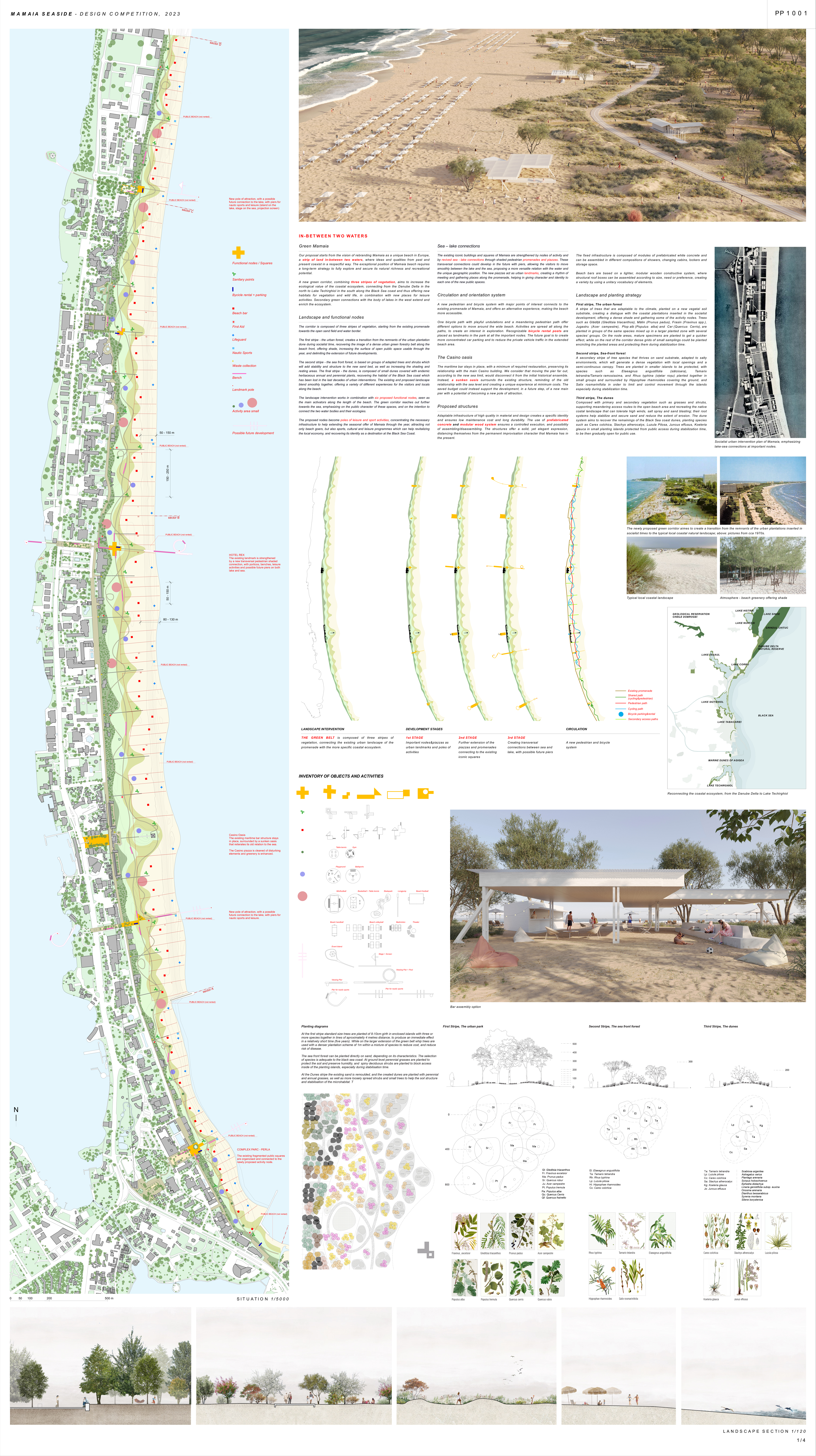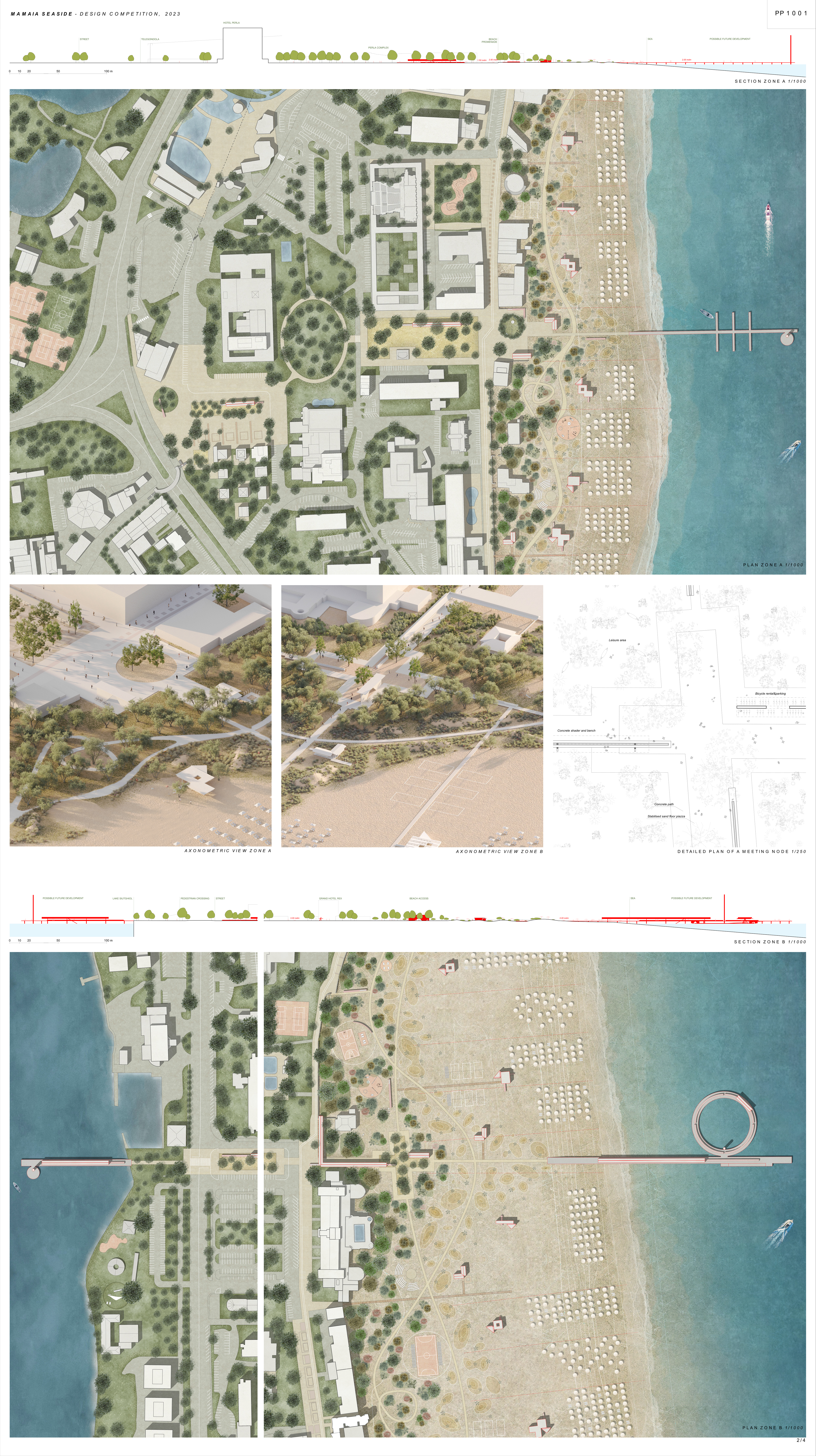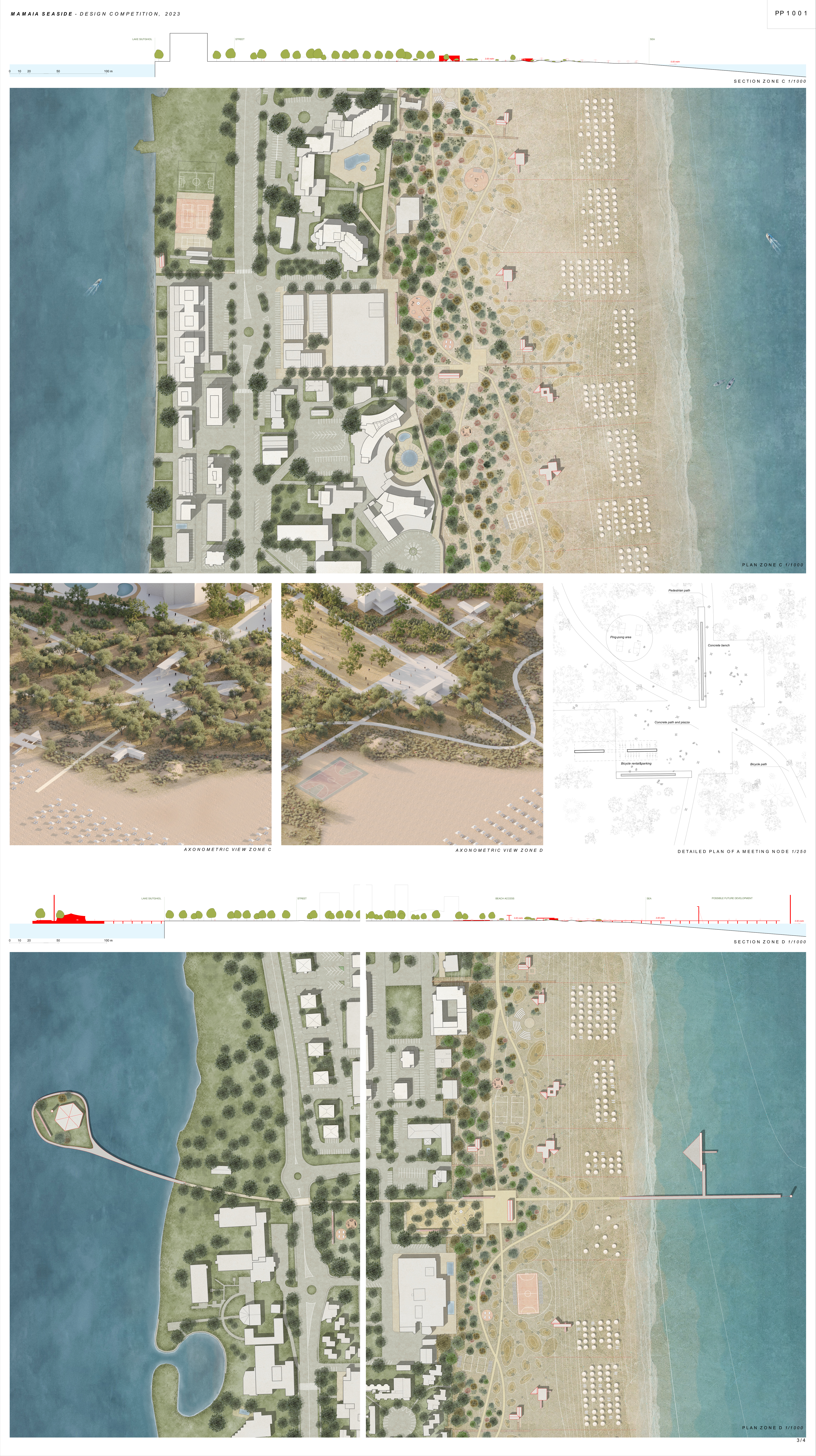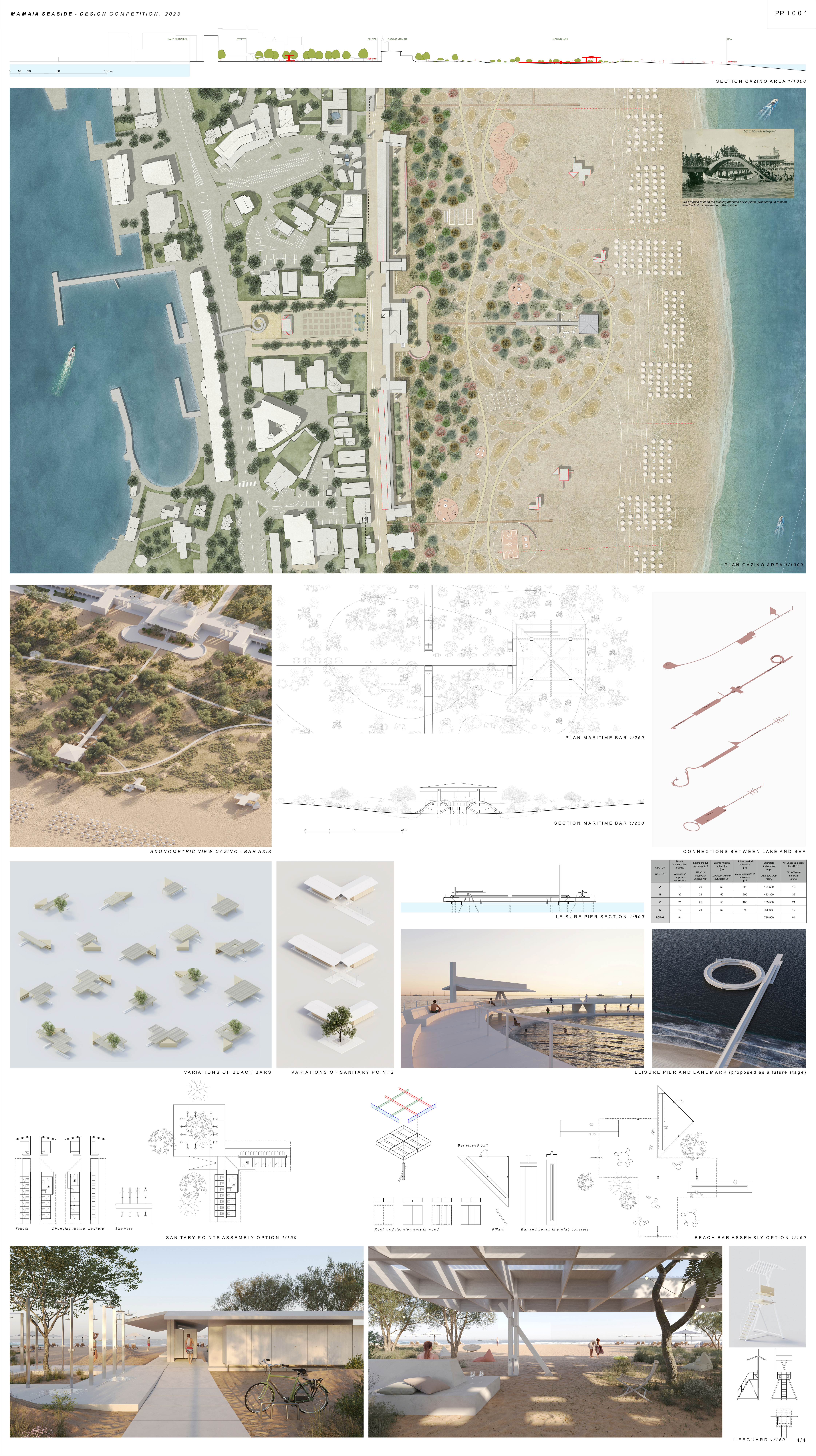103 – PP1001 – PELINU PROJECTS SRL
Main Author: Laura Cristea, Raphael Zuber – PELINU PROJECTS SRL
Co-authors: Christian Beros – BEROS ABDUL ARHITECTI ASOCIATI SRL, Anisia Mouhamed
Architectural collaborators: Adi Bratu, Erich Babă, Ana Brebeanu, Mădălina Dobre, Bianca Dumitru, Ana-Maria Marțiș, Raluca Mihăilă, Andreea Stah, Vera Apostolescu

IN-BETWEEN TWO WATERS
1. Green Mamaia
Our proposal starts from the vision of rebranding Mamaia as a unique beach in Europe, a strip of land in-between two waters, where ideas and qualities from past and present coexist in a respectful way. The exceptional position of Mamaia beach requires a long-term strategy to fully explore and secure its natural richness and recreational potential.
2. A new green corridor
A new green corridor, combining three stripes of vegetation, aims to increase the ecological value of the coastal ecosystem, connecting from the Danube Delta in the north to Lake Techirghiol in the south along the Black Sea coast and thus offering new habitats for vegetation and wild life, in combination with new places for leisure activities. Secondary green connections with the body of lakes in the west extend and enrich the ecosystem.

3. Landscape and functional nodes
The corridor is composed of three stripes of vegetation, starting from the existing promenade towards the open sand field and water border.
The first stripe – the urban forest, creates a transition from the remnants of the urban plantation done during socialist time, recovering the image of a dense urban green forestry belt along the beach front, offering shade, increasing the surface of open public space usable through the year, and delimiting the extension of future developments.
The second stripe – the sea front forest, is based on groups of adapted trees and shrubs which will add stability and structure to the new sand bed, as well as increasing the shading and resting areas. The final stripe – the dunes, is composed of small dunes covered with endemic herbaceous annual and perennial plants, recovering the habitat of the Black Sea coast which has been lost in the last decades of urban interventions. The existing and proposed landscape blend smoothly together, offering a variety of different experiences for the visitors and locals along the beach.
The landscape intervention works in combination with six proposed functional nodes, seen as the main activators along the length of the beach. The green corridor reaches out further towards the sea, emphasizing on the public character of these spaces, and on the intention to connect the two water bodies and their ecologies.
The proposed nodes become poles of leisure and sport activities, concentrating the necessary infrastructure to help extending the seasonal offer of Mamaia through the year, attracting not only beach goers, but also sports, cultural and leisure programmes which can help revitalizing the local economy, and recovering its identity as a destination at the Black Sea Coast.

4. Sea – lake connections
The existing iconic buildings and squares of Mamaia are strengthened by nodes of activity and by revived sea-lake connections through shaded pedestrian promenades and piazzas. These transversal connections could develop in the future with piers, allowing the visitors to move smoothly between the lake and the sea, proposing a more versatile relation with the water and the unique geographic position. The new piazzas act as urban landmarks, creating a rhythm of meeting and gathering places along the promenade, helping in giving character and identity to each one of the new public spaces.
5. Circulation and orientation system
A new pedestrian and bicycle system with major points of interest connects to the existing promenade of Mamaia, and offers an alternative experience, making the beach more accessible.
One bicycle path with playful undulations and a meandering pedestrian path offer different options to move around the wide beach. Activities are spread all along the paths, to create an interest in exploration. Recognizable bicycle rental posts are placed as landmarks in the park at all the important nodes. The future goal is to create more concentrated car parking and to reduce the private vehicle traffic in the extended beach area.
6. The Casino oasis
The maritime bar stays in place, with a minimum of required restauration, preserving its relationship with the main Casino building. We consider that moving the pier far out, according to the new sea limit, would disconnect it from the initial historical ensemble. Instead, a sunken oasis surrounds the existing structure, reminding of the old relationship with the sea level and creating a unique experience at minimum costs. The saved budget could instead support the development, in a future step, of a new main pier with a potential of becoming a new pole of attraction.

7. Proposed structures
Adaptable infrastructure of high quality in material and design creates a specific identity and ensures low maintenance cost and long durability. The use of prefabricated concrete and modular wood system ensures a controlled execution, and possibility of assembling/disassembling. The structures offer a solid, yet elegant expression, distancing themselves from the permanent improvisation character that Mamaia has in the present.
The fixed infrastructure is composed of modules of prefabricated white concrete and can be assembled in different compositions of showers, changing cabins, lockers and storage space.
Beach bars are based on a lighter, modular wooden constructive system, where structural roof boxes can be assembled according to size, need or preference, creating a variety by using a unitary vocabulary of elements.
8. Landscape and planting strategy
First stripe, The urban forest
A stripe of trees that are adaptable to the climate, planted on a new vegetal soil substrate, creating a dialogue with the coastal plantations inserted in the socialist development, offering a dense shade and gathering some of the activity nodes. Trees such as Glădiță (Gleditsia triacanthos), Mălin (Prunus padus), Frasin (Fraxinus spp.), Jugastru (Acer campestre), Plop alb (Populus alba) and Cer (Quercus Cerris), are planted in groups of the same species mixed up in a larger planted zone with several species’ groups. On the node areas, mature specimens are planted to get a quicker effect, while on the rest of the corridor dense grids of small samplings could be planted encircling the planted areas and protecting them during stabilization time.
Second stripe, Sea-front forest
A secondary stripe of tree species that thrives on sand substrate, adapted to salty environments, which will generate a dense vegetation with local openings and a semi-continuous canopy. Trees are planted in smaller islands to be protected, with species such as Elaeagnus angustifolia (sălcioara), Tamarix tetrandra/Tamarix ramosissima, and Rhus typhina (oțetar roșu) planted together in small groups and surrounded by Hippophae rhamnoides covering the ground, and Salix rosmarinifolia in order to limit and control movement through the islands especially during stabilization time.
Third stripe, The dunes
Composed with primary and secondary vegetation such as grasses and shrubs, supporting meandering access routes to the open beach area and recreating the native costal landscape that can tolerate high winds, salt spray and sand blasting; their root systems help stabilize and secure sand and reduce the extent of erosion. The dune system aims to recover the remainings of the Black Sea coast dunes, planting species such as Carex colchica, Stachys atherocalyx, Luzula Pilosa, Juncus effusus, Koeleria glauca in small planting islands protected from public access during stabilization time, to be then gradually open for public use.











